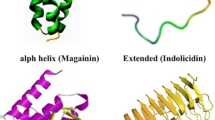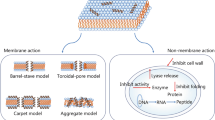Abstract
Antibacterial peptides have potential as novel therapeutic agents for bacterial infections. Aurein 1.2 is one of the smallest antibacterial peptides extracted from an anuran. LLAA is a more active analogue of aurein 1.2. Antibacterial peptides usually accomplish their function by interacting with bacterial membrane selectively. In this study, we tried to find the reasons for the stronger antibacterial activity of LLAA compared with aurein 1.2. For this purpose, the interaction of aurein 1.2 and LLAA with dipalmitoylphosphatidylcholine (DPPC) was investigated by molecular dynamics (MD) simulation. In addition, the structure of peptides and their antibacterial activity were investigated by circular dichroism (CD) and dilution test method, respectively. MD results showed that LLAA is more flexible compared with aurein 1.2. Furthermore, LLAA loses its structure more than aurein 1.2 in the DPPC bilayer. A higher amount of water molecules penetrate into bilayer in the presence of LLAA relative to aurein 1.2. According to the antibacterial result that indicated LLAA is remarkably more active than aurein 1.2, it can be concluded that flexibility of the peptide is a determining factor in antibacterial activity. Probably, flexibility of the peptides facilitates formation of effective pores in the lipid bilayer.







Similar content being viewed by others
References
Bahar, A.A., Ren, D.: Antimicrobial peptides. Pharmaceuticals 6(12), 1543–1575 (2013)
Yeung, A.T., Gellatly, S.L., Hancock, R.E.: Multifunctional cationic host defence peptides and their clinical applications. Cell. Mol. Life Sci. 68(13), 2161–2176 (2011)
Hoskin, D.W., Ramamoorthy, A.: Studies on anticancer activities of antimicrobial peptides. Biochim. Biophys. Acta. 1778(2), 357–375 (2008)
Al-Benna, S., Shai, Y., Jacobsen, F., Steinstraesser, L.: Oncolytic activities of host defense peptides. Int. J. Mol. Sci. 12(11), 8027–8051 (2011)
Yates, C., Sharp, S., Jones, J., Topps, D., Coleman, M., Aneja, R., Jaynes, J., Turner, T.: LHRH-conjugated lytic peptides directly target prostate cancer cells. Biochem. Pharmacol. 81(1), 104–110 (2011)
Wang, G., Li, X., Wang, Z.: APD2: the updated antimicrobial peptide database and its application in peptide design. Nucleic Acids Res. 37(suppl 1), D933–D937 (2009)
Zasloff, M.: Antimicrobial peptides of multicellular organisms. Nature 415(6870), 389–395 (2002)
Brogden, K.A.: Antimicrobial peptides: pore formers or metabolic inhibitors in bacteria? Nat. Rev. Microbiol. 3(3), 238–250 (2005)
Legrand, B., Mathieu, L., Lebrun, A., Andriamanarivo, S., Lisowski, V., Masurier, N., Zirah, S., Kang, Y.K., Martinez, J., Maillard, L.T.: Thiazole-based γ-building blocks as reverse-turn mimetic to design a gramicidin S analogue: conformational and biological evaluation. Chem. Eur. J. 20(22), 6713–6720 (2014)
Rozek, T., Wegener, K.L., Bowie, J.H., Olver, I.N., Carver, J.A., Wallace, J.C., Tyler, M.J.: The antibiotic and anticancer active aurein peptides from the Australian bell frogs Litoria aurea and Litoria raniformis. Eur. J. Biochem. 267(17), 5330–5341 (2000)
Boland, M.P., Separovic, F.: Membrane interactions of antimicrobial peptides from Australian tree frogs. Biochim. Biophys. Acta. 1758(9), 1178–1183 (2006)
Wang, G., Li, Y., Li, X.: Correlation of three-dimensional structures with the antibacterial activity of a group of peptides designed based on a nontoxic bacterial membrane anchor. J. Biol. Chem. 280(7), 5803–5811 (2005)
Strömstedt, A.A., Ringstad, L., Schmidtchen, A., Malmsten, M.: Interaction between amphiphilic peptides and phospholipid membranes. Curr. Opin. Colloid Interface Sci. 15(6), 467–478 (2010)
Li, X., Li, Y., Peterkofsky, A., Wang, G.: NMR studies of aurein 1.2 analogs. Biochim. Biophys. Acta (BBA) - Biomembr. 1758(9), 1203–1214 (2006)
Tieleman, D.P., Berendsen, H.: Molecular dynamics simulations of a fully hydrated dipalmitoylphosphatidylcholine bilayer with different macroscopic boundary conditions and parameters. J. Chem. Phys. 105(11), 4871–4880 (1996)
Kandt, C., Ash, W.L., Tieleman, D.P.: Setting up and running molecular dynamics simulations of membrane proteins. Methods 41(4), 475–488 (2007)
Mark, P., Nilsson, L.: Structure and dynamics of the TIP3P, SPC, and SPC/E water models at 298 K. J. Phys. Chem. A 105(43), 9954–9960 (2001)
Hess, B., Kutzner, C., Van Der Spoel, D., Lindahl, E.: GROMACS 4: algorithms for highly efficient, load-balanced, and scalable molecular simulation. J. Chem. Theory Comput. 4(3), 435–447 (2008)
Hess, B., Bekker, H., Berendsen, H.J., Fraaije, J.G.: LINCS: a linear constraint solver for molecular simulations. J. Comput. Chem. 18(12), 1463–1472 (1997)
Poger, D., Van Gunsteren, W.F., Mark, A.E.: A new force field for simulating phosphatidylcholine bilayers. J. Comput. Chem. 31(6), 1117–1125 (2010)
Essmann, U., Perera, L., Berkowitz, M.L., Darden, T., Lee, H., Pedersen, L.G.: A smooth particle mesh Ewald method. J. Chem. Phys. 103(19), 8577–8593 (1995)
Nosé, S.: A unified formulation of the constant temperature molecular dynamics methods. J. Chem. Phys. 81(1), 511–519 (1984)
Hoover, W.G.: Canonical dynamics: equilibrium phase-space distributions. Phys. Rev. A 31(3), 1695–1697 (1985)
Nosé, S., Klein, M.L.: Constant pressure molecular dynamics for molecular systems. Mol. Phys. 50(5), 1055–1076 (1983)
Kabsch, W., Sander, C.: Dictionary of protein secondary structure: pattern recognition of hydrogen-bonded and geometrical features. Biopolymers 22(12), 2577–2637 (1983)
Joosten, R.P., Te Beek, T.A., Krieger, E., Hekkelman, M.L., Hooft, R.W., Schneider, R., Sander, C., Vriend, G.: A series of PDB related databases for everyday needs. Nucleic Acids Res. 39(suppl 1), D411–D419 (2011)
Kelly, S.M., Price, N.C.: The use of circular dichroism in the investigation of protein structure and function. Curr. Protein Pept. Sci. 1(4), 349–384 (2000)
Mosmann, T.: Rapid colorimetric assay for cellular growth and survival: application to proliferation and cytotoxicity assays. J. Immunol. Methods 65(1–2), 55–63 (1983)
Khandelia, H., Duelund, L., Pakkanen, K.I., Ipsen, J.H.: Triglyceride blisters in lipid bilayers: implications for lipid droplet biogenesis and the mobile lipid signal in cancer cell membranes. PLoS ONE 5(9), e12811 (2010). doi:10.1371/journal.pone.0012811
Shiraki, K., Nishikawa, K., Goto, Y.: Trifluoroethanol-induced stabilization of the α-helical structure of β-lactoglobulin: implication for non-hierarchical protein folding. J. Mol. Biol. 245(2), 180–194 (1995)
Acknowledgments
Financial support provided by the Research Council of the Institute for Advanced Studies in Basic Sciences is gratefully acknowledged.
Author information
Authors and Affiliations
Corresponding author
Rights and permissions
About this article
Cite this article
Sajjadiyan, Z., Cheraghi, N., Mohammadinejad, S. et al. Interaction of aurein 1.2 and its analogue with DPPC lipid bilayer. J Biol Phys 43, 127–137 (2017). https://doi.org/10.1007/s10867-016-9438-z
Received:
Accepted:
Published:
Issue Date:
DOI: https://doi.org/10.1007/s10867-016-9438-z




